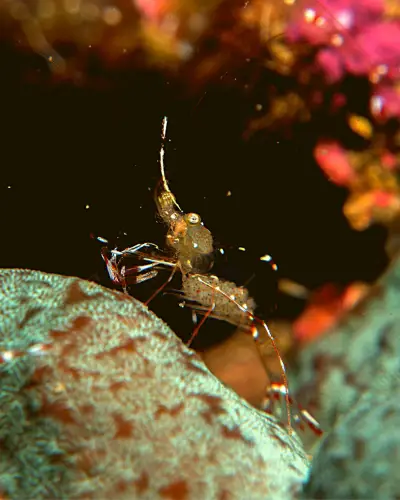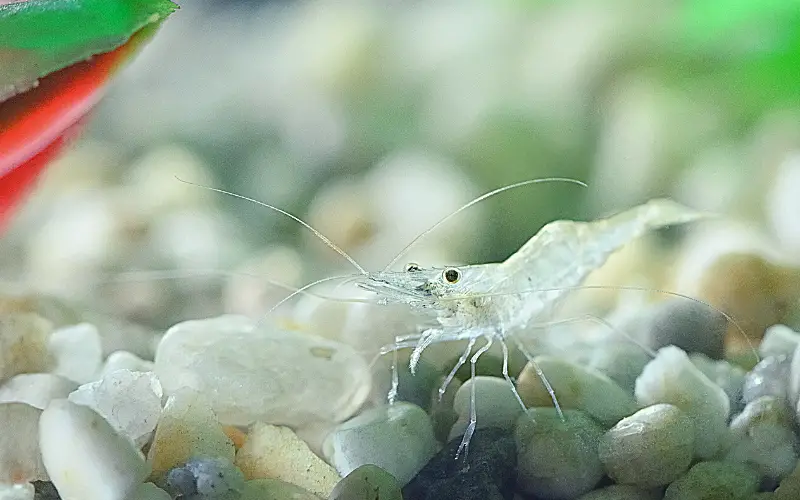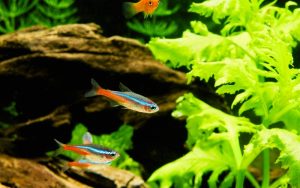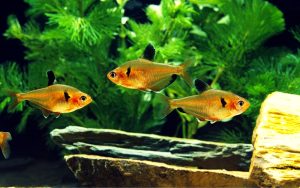Ich is a common parasitic infection affecting fish, but can ghost shrimp get ich? The answer is no; ghost shrimp cannot get ich. Ich parasites can only infect fish, and they cannot survive on the exoskeleton of a shrimp.
However, ghost shrimp can still be carriers of ich and transmit the parasite to fish in their tank. If you have a ghost shrimp tank, keeping the water clean and well-maintained is essential to prevent the spread of ich.
It would help to quarantine any new fish before adding them to your tank to ensure they are not infected with ich.
If you’re an aquarium enthusiast, you’re likely familiar with the challenges of keeping a diverse aquatic life community.

Among the many potential concerns, one that often plagues freshwater aquariums is the dreaded ich, or “white spot disease.” While commonly associated with fish, can ghost shrimp also get sick from ich?
This article’ll explore the signs, symptoms, and preventive measures associated with this pesky parasite in shrimp tanks. We’ll dive into the intricacies of identifying and addressing ich to ensure your aquatic companions thrive in their freshwater haven.
Table of Contents
ToggleCan Ghost Shrimp Get Ich in a Tank?
Can Ghost Shrimp Carry ICH? Ghost shrimp can carry ich, also known as ick or white spot disease. Ich is a widespread parasitic infection that affects fish and other aquatic animals, including shrimp. It is caused by a parasite labeled Ichthyophthirius multifiliis, which attaches itself to the skin and gills of the host.
While the infection primarily affects fish, ghost shrimp can also contract ich if they come in contact with infected water or other infected shrimp.

The parasite can quickly spread ich from one shrimp to another within the same tank or aquarium. Infected shrimp may exhibit symptoms such as white spots on their bodies, increased scratching or rubbing against surfaces, and changes in behavior or appetite.
It is important to promptly address ich outbreaks to prevent further spread and potential harm to the ghost shrimp population in the tank. Regular maintenance of water quality and quarantine measures can help minimize the risk of ich affecting ghost shrimp and other aquatic creatures in the aquarium.
The Intricacies of Ich and Its Effects on Shrimp
Ich, scientifically known as Ichthyophthirius multifiliis, is a parasitic ciliate that attaches itself to fish and other aquatic creatures. While it primarily affects fish, whether it can affect shrimp, such as ghost shrimp, has become a concern among aquarists.
The Ghost Shrimp and Their Vulnerability
Ghost shrimp, a popular addition to freshwater aquariums, are generally hardy and adaptable. However, like all creatures, they are susceptible to various diseases and parasites. The presence of ich in a tank can spell trouble for these delicate crustaceans.
7 Signs that Your Ghost Shrimp Might Have Ich
1. Strange Behavior and Agitation
Watch for unusual behavior, such as increased restlessness and agitation among your ghost shrimp. If they appear constantly on the move, scratching against surfaces or twitching.
2. White Spots and Cloudy Appearance
Ich manifests as small white spots, often described as resembling grains of salt, on the skin and fins of fish. In ghost shrimp, these spots may appear cloudy or slightly opaque due to their translucent bodies.
3. Decreased Appetite and Feeding Patterns
Notice a sudden lack of interest in food among your ghost shrimp? Changes in feeding behavior can indicate underlying health issues, including ich infestations.
4. Clamped Fins and Labored Movement
Infected shrimp might display clamped fins, where their appendages are held tightly against their bodies. Additionally, their movement may become sluggish and strained.
5. Respiratory Distress and Rapid Gill Movement
As ich takes hold, ghost shrimp may experience difficulty breathing. You might observe the rapid movement of their gills as they struggle to obtain oxygen.
6. Hiding and Unusual Resting Places
Healthy ghost shrimp are typically active and visible. It could be a sign of distress if you notice your shrimp spending an unusual amount of time hiding or resting in obscure corners of the tank.
7. Increased Mortality Among Tank Mates
In a community tank, keep an eye on the overall health of your aquatic inhabitants. A sudden increase in mortality, especially among fish, could indicate an ich outbreak that might also affect the shrimp.
Taking Action: Treating and Preventing Ich in Ghost Shrimp Tanks
– Quarantine Measures: A Prudent Approach
One of the most effective strategies to prevent and control ich is through proper quarantine procedures. Before introducing any new inhabitants, such as plants, snails, or fish, into your shrimp tank, ensure they undergo a quarantine period.
– Temperature Elevation for Treatment
Raising the temperature of the tank can aid in treating ich. While ghost shrimp can tolerate slightly elevated temperatures, it’s crucial to strike a balance that effectively targets the parasite without causing harm to your shrimp.
– Medications and Ich Treatments
Several commercial medications and treatments are available to combat ich infestations. However, exercise caution when using these products in a tank with ghost shrimp. Always follow the manufacturer’s instructions and monitor your shrimp closely for any adverse reactions.
– The Importance of a Separate Treatment Tank
In severe cases of ich, creating a separate treatment tank might be necessary. This isolation can prevent the parasite from spreading to other tank inhabitants and provide a controlled environment for treatment.
– Patience and Observation
Ich treatment requires patience and keen observation. Monitor your tank closely, looking for improvement in your ghost shrimp’s behavior and appearance.
If you want to add salt, it’s essential to consider the specific type of shrimp we’re discussing. For example, if we’re talking about ghosts or amano shrimp, I’ve placed them directly into high brackish water without acclimation and used them as feeders.
They thrived in that environment for several months. However, I would exercise caution if we’re dealing with more delicate or rare shrimp species, although they would likely still adapt well to the conditions.
How Do You Treat Ich in a Shrimp Tank?
Ich is a common freshwater parasite that can infect fish but does not affect shrimp. So, if you have ghost shrimp in your tank and notice any signs of ich, such as white spots on the fish, you can treat the tank without worrying about harming the shrimp.
Here are some steps on how to treat ich in a shrimp tank:
- Raise the water temperature. Ich parasites are more susceptible to heat, so raising the water temperature to 82-86 degrees Fahrenheit can help to kill them. You can do this gradually over 24 hours to avoid stressing the fish.
- Add aquarium salt. Aquarium salt can also help to kill ich parasites. Add one tablespoon of API aquarium salt per gallon of water.
- Use a commercial ich treatment. Several commercial ich treatments are available that are safe for use in shrimp tanks. Follow the written instructions on the product label carefully.
- Do daily water changes. This will help to remove any ich parasites that have been released from the fish.
- Monitor the tank closely. Continue treatment for at least seven days after the last signs of ich have disappeared.
With proper treatment, ich can usually be cured in a shrimp tank without harming the shrimp. However, it is essential to note that some ich treatments can harm plants, so it is crucial to read the product label carefully before using it.
Here are some additional tips for preventing ich in shrimp tanks:
- Keep the water quality high. This means regular water changes and testing the water for ammonia, nitrite, and nitrate levels.
- Quarantine the new fish for at least two weeks before adding them to the main community tank. This will help to prevent the introduction of ich parasites into the tank.
- Avoid overcrowding the tank. This might stress the fish and make them more susceptible to disease.
- Add plants to the tank. Plants can help to filter the water and provide hiding places for the shrimp.
By following these tips, you can help to prevent ich from infecting your shrimp tank.
Will Ich Go Away on Its Own?
Many fish enthusiasts often wonder if ich will go away on its own. Unfortunately, this is rarely the case. Ich is highly contagious, and if left untreated, it can spread rapidly throughout your tank, endangering the health and well-being of all your aquatic inhabitants.
The parasite has a complex life cycle, including a free-swimming stage, during which it can infect other fish. Therefore, taking immediate action to eradicate ich from your tank is crucial.
Treatments such as medication and raising the shrimp tank’s temperature can help eliminate the parasite and prevent its reoccurrence, ensuring a healthy and thriving aquatic environment.
What to Do To Prevent Ich From Entering The Tank?
You can take several precautions to prevent ich from entering your tank and infecting your freshwater shrimp or fish. Here’s what you can do:
- Quarantine new additions: Before introducing freshwater shrimp or fish to your main tank, quarantine them in a separate tank for at least 60 days. This will help you observe and identify any potential signs of ich or other diseases they may carry.
- Inspect for evidence of ich: During the quarantine period, closely monitor the quarantined shrimp or fish for any signs of ich. Look for small white spots resembling grains of salt on their bodies, fins, or gills. These spots can indicate an ich infection.
- Treat the quarantine tank: If you notice any evidence of ich during the quarantine period, you can treat the affected shrimp or fish in a separate tank. There are various chemicals available in the market specifically designed to treat ich. Follow the guidance on the product label for proper dosage and duration of treatment.
- Wait for ich to die without a host: Ich parasites cannot survive within seven days. The ich parasites will eventually die off by keeping the infected shrimp or fish in the quarantine tank and treating them.
- Clean and disinfect equipment: After the quarantine period is over and the shrimp or fish show no signs of ich, thoroughly clean and disinfect any equipment used in the quarantine tank. This includes nets, heaters, filters, and decorations or hiding spots. This step will help eliminate any potential ich parasites that might still be present.
- Introduce healthy shrimp or fish to the main tank: Once the quarantine period is complete and you have ensured that the shrimp or fish are free from ich, you can introduce them to the main tank. Following the quarantine process reduces the risk of introducing ich or other diseases to your established tank population.
Remember, prevention is critical when dealing with ich. Taking the time to quarantine and observe new additions can help avoid introducing ich to your main tank, keeping your shrimp and fish healthy.
FAQs About Freshwater Shrimp and Ich
Are ghost shrimp susceptible to ich?
Do ghost shrimp get ich? Yes, ghost shrimp can be affected by ich, a parasitic ciliate that attaches to aquatic creatures.
How can I tell if my ghost shrimp have ich?
Look for signs such as white spots, agitation, clamped fins, decreased appetite, and unusual hiding behavior.
Can ich spread to other tank inhabitants?
Yes, ich can quickly spread to other fish and shrimp in the same fish tank.
Can ich be treated in a shrimp tank?
Yes, ich can be treated in a shrimp tank using various methods, including temperature elevation and medications.
Is ich fatal to ghost shrimp?
With proper treatment and care, ich is a treatable parasite, and ghost shrimp can recover from its effects.
Can one fish getting ich cause all the other fish to get it?
Yes, if one fish gets ich, there is a possibility that it can spread to other fish in the tank.
Can cleaner shrimp help with ich?
Cleaner shrimp are often used to help prevent and control ich in the tank.
Are shrimp completely safe from ich?
Shrimp are not affected by ich and are considered safe from contracting the parasite.
How does ich spread?
Ich spreads through ich tomonts, which are the eggs of the parasite. The tomonts hatch and attach to fish, causing them to become infected.
How can I treat ich in my tank?
Various treatments are available to treat ich in the tank, such as medications and raising the water temperature.
Can I add new fish to my tank if it has ich?
Adding new fish to a tank with ich is not recommended, as it can spread to the new fish and cause them to become infected.
How long does ich last in a tank?
The life cycle of ich can vary, but with proper treatment, the parasite can be eradicated within a few weeks.
What is the best way to prevent problems with ich?
The best way to prevent ich is to quarantine new pet fish before adding them to the community tank and maintain good water quality and tank hygiene.
Conclusion
So, can shrimp get ich? This blog post taught us about the common freshwater parasite known as ich, or white spot disease. We also learned that ghost shrimp could not get ich, as they are unsuitable hosts for the parasite. However, other diseases, such as bacterial infections and molting problems, can still affect ghost shrimp. Keeping your ghost shrimp tank clean and well-maintained is essential to help prevent these diseases. If you are concerned about the health of your ghost shrimp, it is always best to consult with a qualified aquarist. They can help you diagnose any problems and recommend the best course of treatment.
Can ghost shrimp get ich? No, ghost shrimp cannot get ich. Ich is a parasite that can only infect fish. Ghost shrimp have a different body structure than fish, and the ich parasite cannot attach to its exoskeleton. However, other diseases, such as bacterial infections and molting problems, can still affect ghost shrimp. Keeping your ghost shrimp tank clean and well-maintained is vital to help prevent these diseases.
You might also like
- Red Cherry Shrimp Temperature: The 72°F Secret Breeding Success
- Are Ghost Shrimp Nocturnal: The Answer Might Surprise You!
- Do Ghost Shrimp Eat Snails: The Answer Might Surprise You!
- Can Ghost Shrimp Live with Cherry Shrimp: A Detailed Answer!
- How Many Babies Do Ghost Shrimp Have: A Comprehensive Guide
- Are Ghost Shrimp Good Cleaners: 3 Surprising Tips!
- Ghost Shrimp Texas Regulations: 5 Hacks for Epic Catches!
- Ghost Shrimp Parasites: 3 Quick Fixes for Horsehair Worms!
- Does Shrimp Shed Their Skin? 3 Surprising Facts About Molting!





